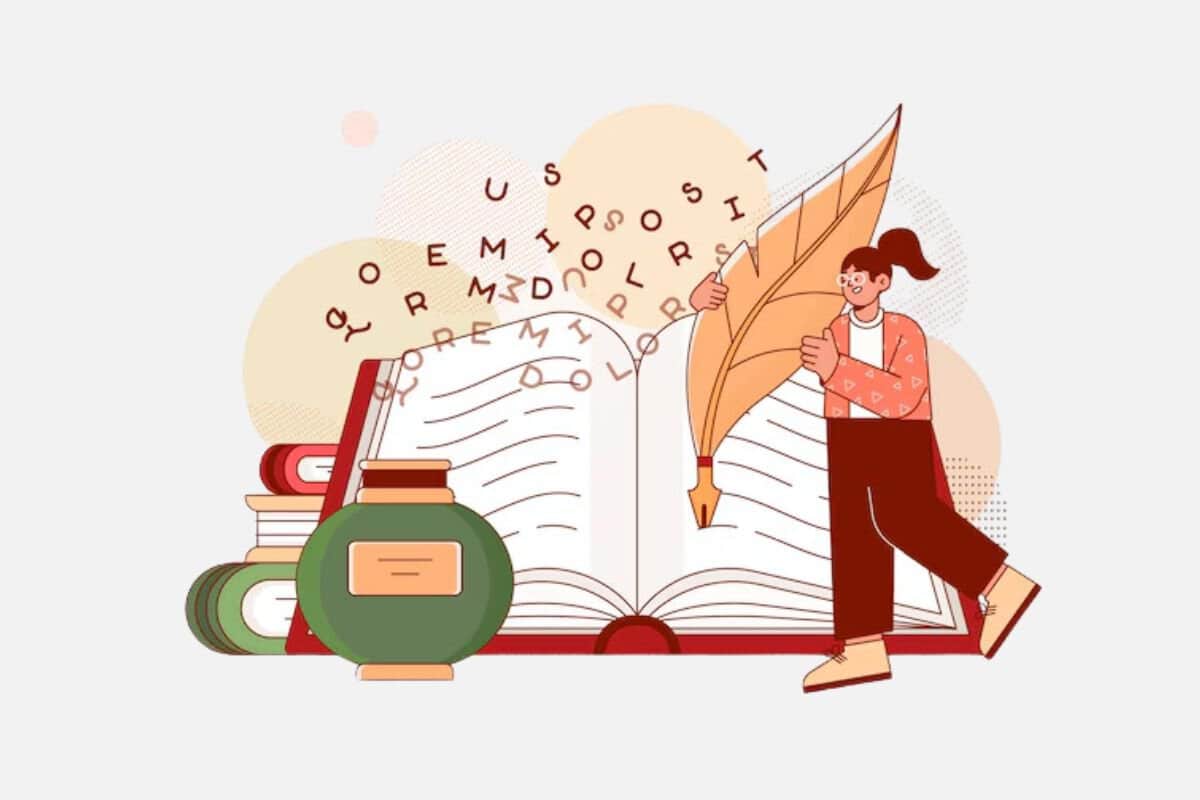Novice writers often fear writing poems even though all it takes is to write with genuine words.
Poem writing lacks major rules yet requires careful word selection to convey targeted emotions and meanings.
What guidelines should you follow to create a poem?
Discover how writing poems can enhance your writing abilities and creative thinking.
How Poetry Can Improve Writing Skills and Creativity
Poetry is an art form that involves creative writing, so do not be afraid to take risks with your language and writing form.
With poetry, you explore your feelings and turn them into powerful language to evoke something in the reader.
When writing poetry, you build your language skills by practicing new ways of describing things and putting words together.


Never Worry About AI Detecting Your Texts Again. Undetectable AI Can Help You:
- Make your AI assisted writing appear human-like.
- Bypass all major AI detection tools with just one click.
- Use AI safely and confidently in school and work.
If you find yourself always using the same phrasing and structure, writing poetry will challenge your creative side and give you more confidence in wielding new words.
Poetry can also help to build vocabulary because it will expose you to literary devices like personification and metaphors. These devices will add depth and complexity to your essays, reports, and email write-ups.
Using an AI Essay Writer alongside poetry exercises can further refine your writing by suggesting diverse phrasing and stylistic improvements.
Rhyming is another common literary device that plays a significant role in poetry.
It helps to develop pattern recognition skills, which are important for creativity.
Rhyming also encourages writers to play with words, which can lead to more innovative expressions and ideas.
Types of Poetry: Choosing Your Style
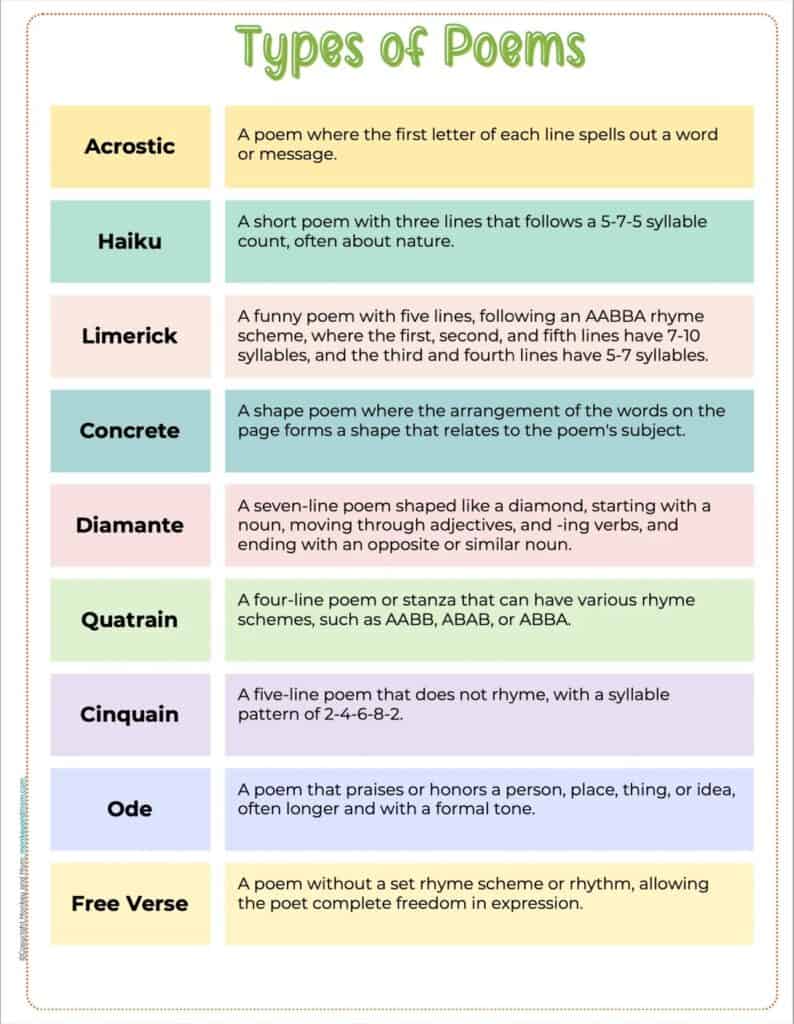
Source: Monkey And Mom
Poetry comes in various types, and choosing between them depends on your creative goals.
Some of the kinds of poetry include:
Free Verse vs. Structured Poetry
Free verse is a popular type of contemporary poetry because it has fewer writing restrictions.
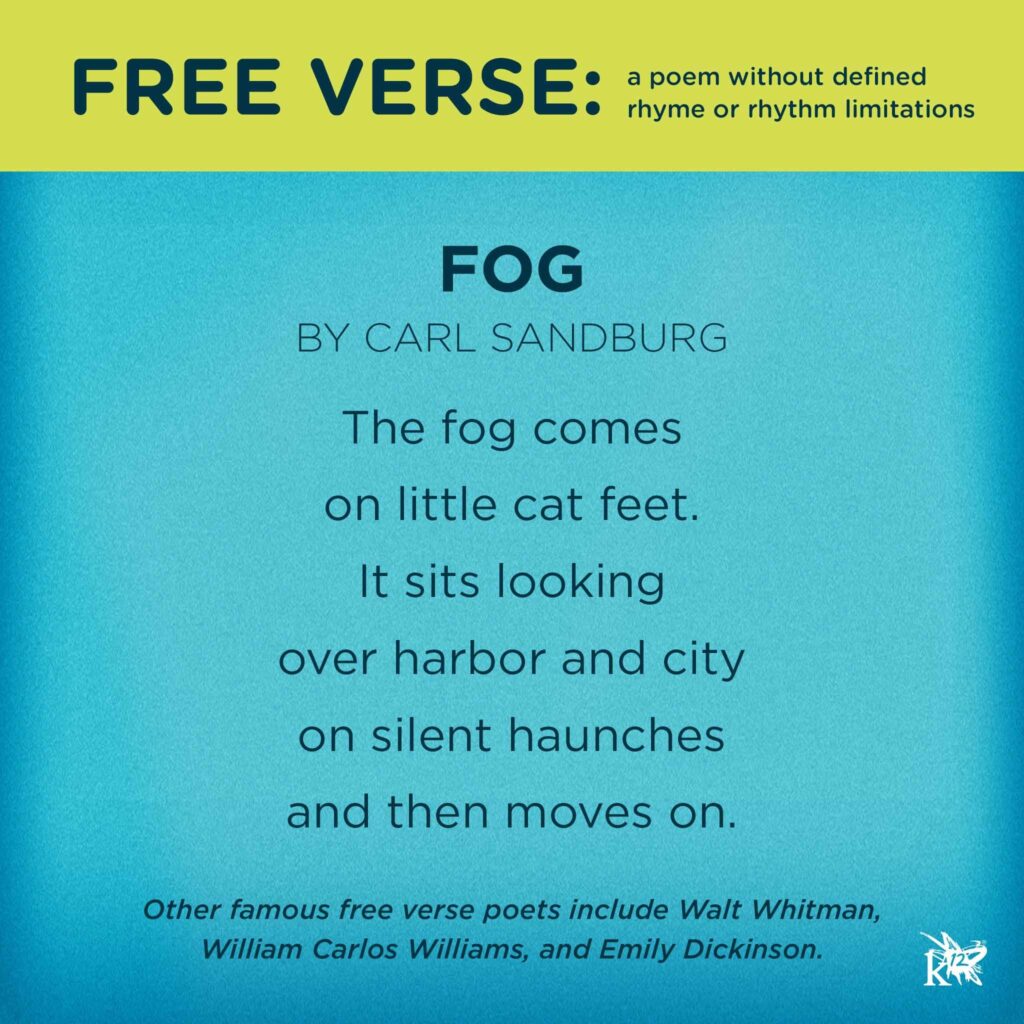
Source: Global Pulse News
It has no consistent form or pattern of syllabic stress because the poet lets the poem structure itself by infusing literary, sound, and language to convey the intended feelings and ideas.
Because of this, free verse tends to follow the rhythm of natural speech.
Unlike free verse poetry, structured poetry requires adherence to a specific format, which includes line length, rhyme patterns, and syllable count.
Educational settings frequently use this style to help students become more confident in writing their poems.
Free verse poetry provides poets with greater flexibility and freedom in word arrangement than structured poetry.
Most readers experience emotional rawness and complex thinking through free verse poetry.
Vivid imagery combined with maximum creative freedom defines free verse poetry, unlike structured poetry, which uses imagery to communicate its message but must follow formal constraints.
Common Poetry Forms
The following are some common forms of poetry:
Haiku (Japanese Syllabic Poetry)
People have favored this traditional Japanese poetic style since ancient times.
Haiku is popular internationally due to its concise dimensions.
The brief structure of haikus allows poets to easily master this form, making it enjoyable to compose.
The poem consists of three lines referred to as tercets, which form a particular meter with five syllables in the first and third lines, while the second line includes seven.
A haiku differs from other poetic forms because it lacks a requirement for rhyme and creates specific emotional states.
Compressing a poem into a few lines makes it difficult to communicate all essential thoughts in the available space.
Sonnet (Shakespearean and Petrarchan)
The Italian origin of the word ‘Sonnetto’ creates ‘Sonnet,’ meaning ‘little song.’
Poets used poetry in 13th-century Italy to create this ancient poetic style.
Petrarch, a poet, perfected the sonnet, which later gained worldwide recognition from William Shakespeare’s pen.
Love is the primary subject of this poetic structure, consisting of fourteen lines.
Inside the sonnet, the rhyming structure adheres to the two established styles of sonnet pattern.
Petrarchan sonnets utilize a pattern of ABBA ABBA CDE CDE for their rhyming scheme, but Shakespearean sonnets use ABAB CDCD EFEF GG.
Limerick (Humorous Five-Line Poem)
Limericks represent comedic five-line verses that might include indecent content.
In the late 19th century, the poetic structure gained widespread popularity.
Edward Lear first made the limerick popular, by bringing humorous content through five poetic lines presenting comical and crude verses in the 19th century.
Poems with an AABBA rhyme pattern structure form the basis of this limerick style, which carries trivial themes.
The main lines of this poetry sequence extend from seven to ten syllables through lines one and two and line five, while lines three and four reach five to seven syllables.
Ballad (Storytelling through Verse)
The ballad is also an old and traditional form of poetry that tells dramatic or emotional stories through verse.
It can either be musical or poetic.
Either way, it follows the pattern of rhymed quatrains, which uses a rhyme scheme of ABCB or ABAB.
This form of poetry is looser than others; hence, writers can modify it to suit their preferences.
Spoken Word Poetry (Performance-Based Poetry)
Spoken word poetry often contains powerful vocal inflections, theatrics, and spontaneity.
This form of poetry has its roots in oral traditions and performances where performers get to read their original pieces aloud to connect with the audience.
It has storytelling, theater, blues, and rap elements because it gives room for repetition, wordplay, and improvisation.
How to Write a Poem
Creating successful, good poetry demands intense work from authors.
This guide explains the procedure on how to write good poetry for beginners and how to write slam poetry in seven sequential steps:
Step 1: Get Inspired
If you already have a theme in mind but want help shaping those first few lines, you can explore our Undetectable AI’s Poem Generator to turn your ideas into an early draft.
It lets you enter a prompt, mood, or topic and quickly shows you how those thoughts can unfold in poem form.
This is useful when you want a place to start but still plan to refine the language with your own creative voice.
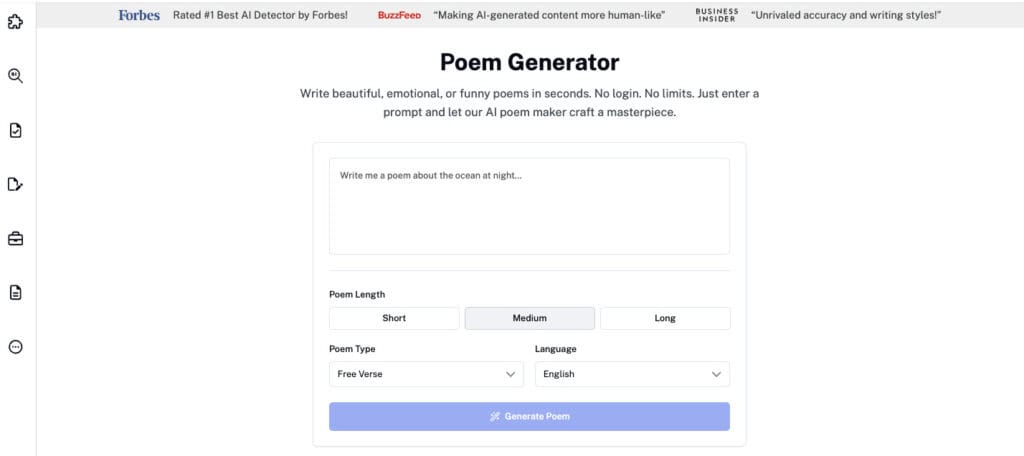
Whether you identify as a writer or not, generating subject matter inspiration is the foundational step on how to write a good poem.
You can find poetic inspiration by studying literary works with real-world occurrences and personal experiences.
You can also use technological advancements like the AI Chat tool on Undetectable AI by asking it to generate prompts, discuss themes, or open lines.

Try asking the AI Chat, “Give me a poetic opening line prompt about hatred,” to get that starting point, then use your unique creativity to bring the poem to life.
You can also experience our AI Detector and Humanizer in action with the widget below!
Step 2: Choose a Theme and Message
In this step, choose the poem’s theme and the message, the idea or emotion you want to convey.
It is important to have a clear message to resonate with the readers.
Step 3: Select a Poetry Structure (Or Go Freeform)
Here, you are to decide on the poetry structure you want, either structured or free verse.
Structured forms have a strict format for rhythm, while free verse gives room for a more flexible style.
Step 4: Experiment with Poetic Devices
Your poem will gain richness through the use of metaphors and imagery, together with alliteration as poetic devices.
Step 5: Write a Draft
Pursue the development of your initial draft by setting aside perfectionism and mental overanalysis.
Your literary delivery of emotions should precede grammatical constraints so that your ideas remain unbound and fluid.
Step 6: Revise and Refine Your Poem
After producing an initial draft, your next step is dedicating time to modify your work until it reaches its finished state.
You should read your poem aloud to detect grammatical mistakes and inappropriate wording, enabling you to confirm that your poem produces the intended mood.
Your poem can benefit from using Undetectable AI, which assists in transforming text expression while maintaining logical reading order.
Step 7: Publish Your Poem
When you are done revising, ensure you are satisfied with your work.
Then, you can publish it and post it on social media or enter it in poetry contests.
Examples of Different Types of Poems
The following are some of the examples of different types of poems:
Example 1: A Haiku About Nature
The Moon Beholders by Matsuo Basho
“From time to time
The clouds give rest
To the moon-beholders.”
Example 2: A Romantic Sonnet
Here is an example on how to write a love poem by William Shakespeare (Sonnet 116):
“Let me not to the marriage of true minds
Admit impediments. Love is not love
Which alters when it alteration finds,
Or bends with the remover to remove:
O no! it is an ever-fixed mark
That looks on tempests and is never shaken;
It is the star to every wandering bark,
Whose worth’s unknown although his height be taken.
Love’s not Time’s fool though rosy lips and cheeks
Within his bending sickle’s compass come:
Love alters not with his brief hours and weeks,
But bears it out even to the edge of doom.
If this be error and upon me proved,
I never writ, nor no man ever loved.”
Example 3: A Spoken Word Poem on Identity
My Heart Leaps Up by William Wordsworth
“My heart leaps up when I behold
A rainbow in the sky:
So was it when my life began;
So is it now I am a man;
So be it when I shall grow old,
Or let me die!
The Child is father of the Man;
And I could wish my days to be
Bound each to each by natural piety.”
Example 4: A Free Verse Poem on Personal Growth
Mirror by Sylvia Plath
“I am silver and exact, I have no preconceptions,
Whatever I see I swallow immediately
Just as it is, unmisted by love or dislike.
I am not cruel, only truthful‚
The eye of a little god, four-cornered.
Most of the time, I meditate on the opposite wall.
It is pink, with speckles. I have looked at it so long
I think it is part of my heart. But it flickers.
Faces and darkness separate us over and over”
Common Mistakes to Avoid in Poetry Writing
The following are some common mistakes to avoid when writing poetry:
Overindulging in Melodrama
Some poets believe that a poem must be very emotional to have a powerful impact.
This belief is not true, as these kinds of poems will overwhelm the audience and exhaust them before they reach the end.
Using Outdated Language
Another common mistake among poets is using outdated language to sound more poetic.
Poetry is meant to connect and be relatable to the reader, and using complicated words can make it difficult for the reader to understand the intended message.
Lazy Editing
After writing your piece, it is important to check your language proficiency.
Always edit your drafts to ensure there are no grammatical errors.
You can also replace any overused words by searching for their synonym online.
Forcing Rhyme Over Meaning
Using rhymes in poems is tricky because some words rhyme more than others.
However, forcing a rhyme compromises your work and can change the direction or rhythm of the poem.
How AI Can Help You Write a Poem
The following are some of the ways you can use AI to write a poem:
- Generating Inspiration: If you have writer’s block, you can use Undetectable AI Chat to provide poem prompts, themes, and an opening line to spark your creativity.
- Offering Style Suggestion: When you’re struggling to decide between a haiku, sonnet, or free verse poem, Undetectable AI chat can guide you in choosing the best format while suggesting poetic devices like metaphors and rhythm to enhance your work.
- Making AI-Generated Poetry Undetectable: You can also use an Undetectable AI Paraphraser to adjust wording and rhythm to create a poem that reads entirely human-written, helping to maintain emotional depth.
- Enhance Word Choice and Flow: You can use an Undetectable AI Paraphrasing tool to rephrase lines, suggest synonyms, and smooth out awkward phrasing in the poem.
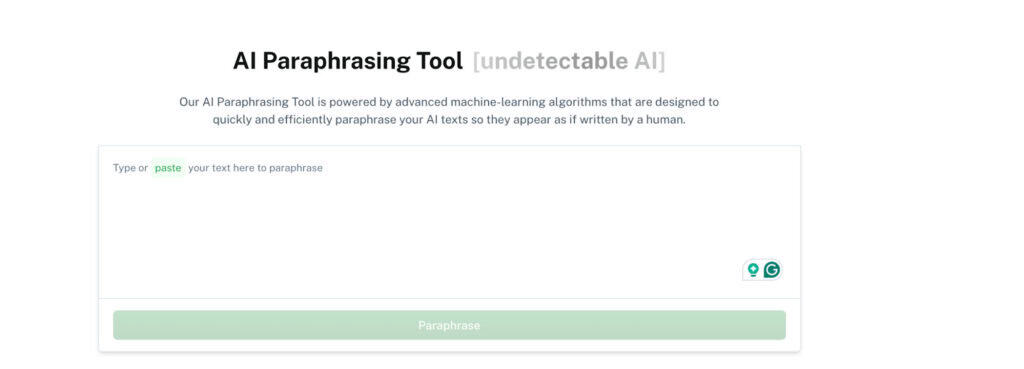
Final Tips for Writing Poetry with Confidence
The following are some tips on how to write poetry with confidence:
- Trust your voice and express your emotions authentically.
- Read more poetry to help refine your skills.
- Play with language to make your poetry resonate with the reader.
- Write without fear and let your words flow naturally before editing.
- Present your poetry to friends and online groups to gather constructive feedback for improvement.
Conclusion
Poetry functions as creative writing because it utilizes tone, meaning, and rhythm to evoke an emotional reaction in the reader.
Both discovering inspiration and refining the final draft in your poem creation journey help you express emotions and ideas more effectively.
Poetry requires creativity and using our AI Chat will make your work more readable and fluent while maintaining originality.
